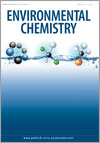
Environmental Chemistry
Scope & Guideline
Pioneering Research for a Healthier Planet
Introduction
Aims and Scopes
- Chemical Analysis and Monitoring:
The journal publishes research that employs advanced analytical techniques to quantify and characterize environmental pollutants, including heavy metals, pesticides, and pharmaceuticals in various matrices. - Environmental Remediation Technologies:
A significant focus is on developing and evaluating innovative methods for the remediation of contaminated environments, including soil and water treatment technologies. - Ecotoxicology and Risk Assessment:
Research exploring the toxicological effects of environmental contaminants on ecosystems and human health is a core area, contributing to risk assessment methodologies. - Biogeochemical Cycling:
Papers often discuss the cycling of elements like nitrogen, phosphorus, arsenic, and selenium in natural environments, highlighting their ecological significance and implications for environmental management. - Sustainable Practices and Green Chemistry:
The journal promotes the development of green chemistry approaches and sustainable practices in environmental management, aiming to minimize adverse effects on ecosystems.
Trending and Emerging
- Emerging Contaminants of Concern:
There is a marked increase in studies examining emerging pollutants, such as microplastics, pharmaceuticals, and personal care products, reflecting growing awareness of their environmental and health impacts. - Climate Change and Chemical Processes:
Research linking chemical processes to climate change, including the effects of pollutants on greenhouse gas emissions and atmospheric chemistry, has gained traction, emphasizing the interconnectedness of chemical and climatic systems. - Green Synthesis and Bioremediation:
An emerging focus on environmentally friendly synthesis methods and bioremediation techniques highlights the journal's commitment to sustainability and reducing chemical footprints. - Advanced Analytical Techniques:
The rise of sophisticated analytical methods, such as mass spectrometry and spectroscopy, is trending, allowing for more precise detection and characterization of contaminants at lower concentrations. - Interdisciplinary Approaches:
There is a growing trend towards interdisciplinary research that integrates environmental chemistry with ecology, toxicology, and social sciences to address complex environmental issues holistically.
Declining or Waning
- Traditional Chemical Contaminants:
Research on conventional pollutants, such as heavy metals and persistent organic pollutants, has decreased as emerging contaminants and new analytical methods gain prominence. - Static Environmental Modeling:
There is a noticeable waning of interest in purely theoretical or static models of environmental processes, as researchers increasingly favor dynamic, data-driven approaches that incorporate real-time environmental monitoring. - Single-Contaminant Studies:
The journal has seen fewer studies focusing solely on single contaminants, as there is a growing trend toward investigating the interactions and cumulative effects of multiple pollutants in complex environmental systems.
Similar Journals
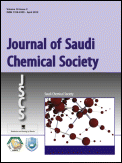
Journal of Saudi Chemical Society
Empowering Chemists Through Open Access Innovation.The Journal of Saudi Chemical Society, published by ELSEVIER, stands as a premier platform for advancing knowledge in the field of chemistry. Since its inception in 2009, this Open Access journal has garnered significant attention, securing a prestigious Q1 ranking in the Chemistry (miscellaneous) category for 2023, reflecting its position among the top journals in the discipline. With an impressive Scopus ranking of #66 out of 408 in General Chemistry, this journal boasts a commendable 83rd percentile, underscoring its impact and relevance in the global research community. The journal aims to disseminate high-quality research articles, reviews, and case studies, fostering innovation and collaboration among chemists and allied professionals. By enabling widespread access to cutting-edge research, the Journal of Saudi Chemical Society plays a crucial role in supporting the educational and professional development of students, researchers, and practitioners alike, making it an essential resource for anyone invested in the dynamic field of chemistry.

Jordan Journal of Chemistry
Shaping the Future: Pioneering Chemistry Research and Education.The Jordan Journal of Chemistry is a prominent publication dedicated to advancing the field of chemistry in Jordan and beyond. Published by the Yarmouk University Deanship of Research & Graduate Studies, this journal serves as a platform for researchers, educators, and practitioners to disseminate their findings in a variety of chemistry sub-disciplines. Although currently classified in Q4 of miscellaneous chemistry and ranking within the 9th percentile according to Scopus, the journal plays a crucial role in fostering academic dialogue and collaboration in the region. With its ISSN 1814-9111 and E-ISSN 2079-7249, the Jordan Journal of Chemistry offers open access to researchers from diverse backgrounds, ensuring that critical research is both accessible and impactful. By bridging local studies with global scientific advancements, this journal is poised to contribute significantly to the growth and recognition of chemistry as a key scientific discipline in the region, with convergence efforts set from 2020 to 2024.

ACS ES&T Engineering
Innovating for a Sustainable Future in Engineering and Chemistry.ACS ES&T Engineering, published by the American Chemical Society, stands as a leading journal in the realm of Chemical Engineering, Environmental Chemistry, and related fields, with a notable Impact Factor indicative of its scholarly influence. Emerging from 2021 with a vision to address contemporary challenges in engineering and environmental health, this Journal not only covers critical studies in Chemical Engineering but also excels in areas such as Process Chemistry and Technology, aligning with its Q1 status across several categories in 2023. With exceptional rankings in Scopus, including a percentile rank in the 90th for Chemical Health and Safety, it offers a significant platform for researchers, educators, and practitioners to disseminate innovative research and practices. Although the journal maintains a subscription model, its commitment to rigorous peer review and high-quality content ensures that readers gain access to pivotal findings essential for advancing knowledge and practice in a rapidly evolving scientific landscape. For those dedicated to tackling global engineering challenges, ACS ES&T Engineering is an invaluable resource.
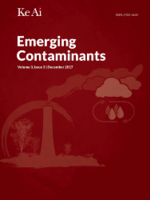
Emerging Contaminants
Navigating the complexities of emerging pollutants.Emerging Contaminants is a leading international journal dedicated to the exploration and analysis of novel pollutants, their effects, and the methodologies for their detection and remediation. Published by KEAI PUBLISHING LTD in China, this Open Access journal has been at the forefront of scientific discourse since its inception in 2015, allowing unrestricted access to cutting-edge research. With an impressive categorization in the top Q1 quartile across diverse fields, including Health, Toxicology and Mutagenesis, and Public Health, it ranks remarkably high—41st out of 665 in Public Health and 10th out of 133 in Toxicology according to Scopus metrics, demonstrating its vital role in advancing our understanding of environmental health risks. By bridging the gap between academia and practical applications, Emerging Contaminants not only enriches the scientific community but also serves as an essential resource for policymakers and industry leaders seeking effective solutions to environmental challenges. Researchers, professionals, and students alike are encouraged to engage with the journal’s comprehensive studies and findings, contributing to a sustainable future.

ENVIRONMENTAL ENGINEERING SCIENCE
Pioneering research for a sustainable future.ENVIRONMENTAL ENGINEERING SCIENCE is a leading journal published by MARY ANN LIEBERT, INC that provides a platform for pioneering research in the fields of environmental chemistry, pollution control, and waste management. With an ISSN of 1092-8758 and an E-ISSN of 1557-9018, this peer-reviewed journal aims to disseminate high-quality scientific studies that address critical environmental challenges. As evidenced by its 2023 category quartile rankings, it holds a notable position at Q3 in Environmental Chemistry and Pollution and Q2 in Waste Management and Disposal, highlighting its relevance and impact in these domains. Spanning over two decades from 1997 to 2024, the journal is dedicated to fostering innovations and promoting rigorous scholarship that can contribute significantly to sustainable environmental practices globally. Authors and researchers are encouraged to engage with this essential resource, which offers Open Access options to enhance the visibility and reach of their work. For those interested in advancing their understanding and practice within the environmental sciences, ENVIRONMENTAL ENGINEERING SCIENCE is an indispensable journal to consider.
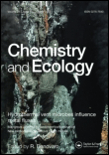
CHEMISTRY AND ECOLOGY
Exploring the Interplay of Chemistry and EcologyCHEMISTRY AND ECOLOGY is a prestigious academic journal published by TAYLOR & FRANCIS LTD, dedicated to advancing the interdisciplinary understanding of chemical processes in ecological systems. With an ISSN of 0275-7540 and an E-ISSN of 1029-0370, this journal has been a significant contributor to the fields of Earth and Planetary Sciences, Ecology, and Environmental Science since its inception in 1982. The journal is proudly ranked in the second quartile (Q2) in multiple categories, including Earth and Planetary Sciences and Ecology, reflecting its high impact within these disciplines. Despite not being an open-access publication, it provides valuable insights through rigorous peer-reviewed articles that explore the intricate relationships between chemical phenomena and ecological dynamics. Researchers, professionals, and students can rely on CHEMISTRY AND ECOLOGY for the latest findings and methodologies that drive innovation and understanding in environmental chemistry and ecology, enhancing their work and education in this critical area of study.

Environmental Chemistry Letters
Exploring the chemistry of our planet's future.Environmental Chemistry Letters, published by Springer Heidelberg, stands at the forefront of interdisciplinary research within the field of Environmental Chemistry. Since its inception in 2003, this esteemed journal has provided a dynamic platform for the dissemination of innovative studies and groundbreaking findings, contributing significantly to the understanding of chemical processes affecting the environment. With an impressive impact factor and ranking third out of 147 journals in Environmental Chemistry (98th percentile as per Scopus), it consistently attracts high-quality submissions from researchers around the globe. The journal maintains a Q1 category rank as of 2023, underscoring its prominent position in scholarly discourse. Environmental Chemistry Letters is dedicated to advancing knowledge on contemporary environmental issues, fostering solutions to mitigate chemical pollution, and promoting sustainable practices across various sectors. Researchers, professionals, and students alike will find invaluable resources within its pages as it continues to illuminate the path toward environmental sustainability.

Journal of Hazardous Materials Letters
Elevating awareness and understanding of hazardous materials.Journal of Hazardous Materials Letters, published by ELSEVIER, is a premier open access journal that has rapidly gained prominence in the fields of Environmental Chemistry, Environmental Engineering, Health, Toxicology and Mutagenesis, Pollution, and Waste Management and Disposal since its inception in 2020. With an impressive categorization in the top quartile (Q1) across all its relevant disciplines in 2023, this journal ranks favorably within the Scopus database, positioning itself in the upper echelons of Environmental Science—ranked 23rd in Environmental Engineering and 19th in Health, Toxicology and Mutagenesis among its peers. It serves as a vital platform for the dissemination of high-quality research focused on addressing hazardous materials and their impacts on health and the environment. The journal's commitment to open access facilitates immediate and broad dissemination of research findings, ensuring that essential knowledge reaches a global audience of researchers, professionals, and students eager to advance the field. With its ongoing convergence into 2024, the Journal of Hazardous Materials Letters continues to drive innovation and influence practice in managing hazardous materials for a sustainable future.

JOURNAL OF THE CHEMICAL SOCIETY OF PAKISTAN
Catalyzing Discoveries in the World of Chemistry.JOURNAL OF THE CHEMICAL SOCIETY OF PAKISTAN is a premier academic journal published by the Chemical Society of Pakistan, focusing on advancing the field of chemistry through rigorous research and scholarship. Established in 1996, this journal aims to disseminate high-quality research articles, reviews, and insights pertaining to various subfields of chemistry, making substantial contributions to both local and international scientific communities. With a current impact factor placing it in the Q4 category, the journal continues to foster discussions on emerging trends and innovations within the discipline. Additionally, it holds a Scopus rank of #305 out of 408, highlighting its growing influence despite being positioned in the 25th percentile. Although it is not an open-access journal, it provides a crucial platform for researchers and professionals in Pakistan and worldwide. The JOURNAL OF THE CHEMICAL SOCIETY OF PAKISTAN serves as a valuable resource for students, educators, and industry professionals alike, facilitating the exchange of knowledge and promoting advancements in chemical sciences.
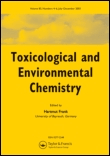
TOXICOLOGICAL AND ENVIRONMENTAL CHEMISTRY
Exploring the impacts of pollutants on our environment and well-being.TOXICOLOGICAL AND ENVIRONMENTAL CHEMISTRY is a pivotal journal published by Taylor & Francis Ltd, addressing critical intersections between environmental chemistry and toxicology since its inception in 1979. With its ISSN 0277-2248 and E-ISSN 1029-0486, the journal serves as a platform for rigorous research and innovative methodologies in pollution control, health implications of environmental chemicals, and the broader spectrum of toxicological studies. Although it currently does not offer open access, the journal's impact in the field is underscored by its Category Quartiles rankings in 2023, placing it in Q3 across Environmental Chemistry, Health, Toxicology and Mutagenesis, and Pollution categories. Furthermore, its Scopus rankings reveal its significant role within the scientific community, specifically in areas such as Environmental Science and Toxicology. The journal aspires to foster multidisciplinary dialogue and advance knowledge that contributes to environmental sustainability and public health, making it an essential resource for researchers, professionals, and students dedicated to these fields.